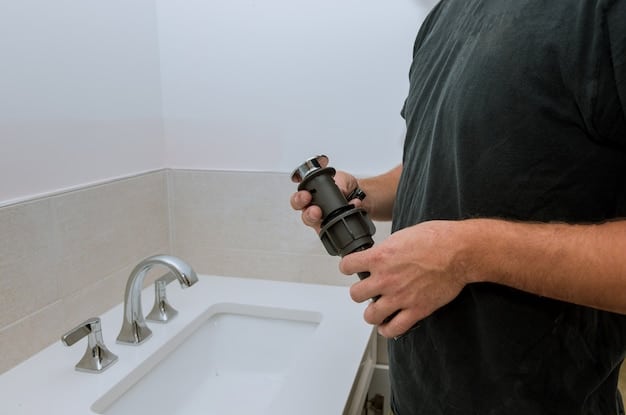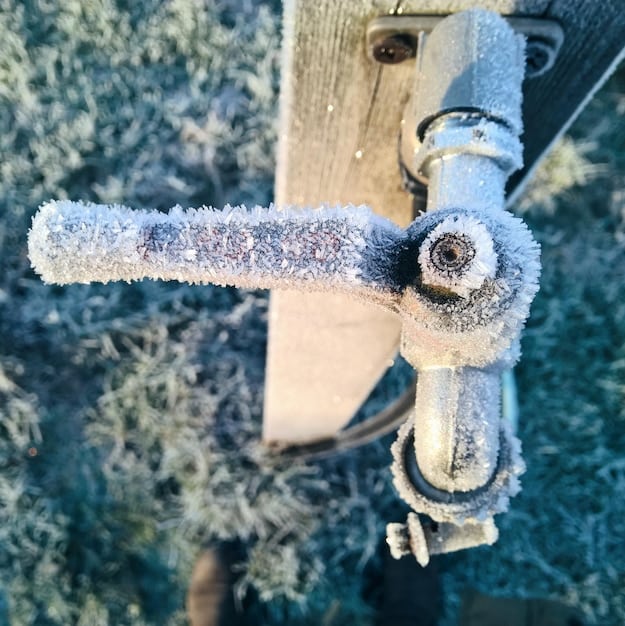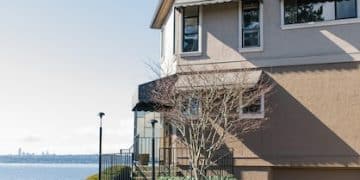Avoid Costly Repairs: 5 Plumbing Maintenance Tips for Homeowners

Avoid costly repairs by implementing these five crucial plumbing maintenance tips, ensuring your home’s plumbing system remains efficient and trouble-free, ultimately saving you from expensive emergencies.
Plumbing issues can be a homeowner’s nightmare, leading to significant damage and hefty repair bills. However, many of these problems can be avoided with proactive maintenance. This article will guide you through five essential avoid costly repairs: 5 plumbing maintenance tips every homeowner should know, helping you safeguard your home and wallet.
Understanding Your Plumbing System
Your home’s plumbing system is a complex network that brings fresh water in and removes waste water out. Understanding the basics of this system is the first step in preventing costly repairs. Knowing where your main water shut-off valve is located, for example, can save you from significant water damage in case of a burst pipe.
Regularly inspecting your plumbing can help you identify potential problems early on. Small leaks, drips, or slow drains can be warning signs of more significant issues lurking beneath the surface. Addressing these minor issues promptly can prevent them from escalating into costly disasters. Let’s explore some targeted areas for inspection to keep your plumbing in top shape.
Key Components of Your Plumbing
Familiarizing yourself with the key components of your plumbing system will make it easier to spot potential issues. These components include pipes, drains, faucets, toilets, water heaters, and various fixtures. Each plays a crucial role in the overall function of the system.
- Pipes: Understanding the different types of pipes used in your home (copper, PVC, PEX) and their common issues.
- Drains: Knowing how to identify and clear minor drain clogs before they become major blockages.
- Water Heater: Understanding how to maintain your water heater to prevent sediment buildup and corrosion.
Regular inspections and basic maintenance for these components can significantly extend the life of your plumbing system and reduce the likelihood of unexpected repairs. Being proactive and informed is the key to maintaining a healthy and efficient plumbing system.
Tip 1: Regularly Check for Leaks
One of the most effective ways to prevent costly plumbing repairs is to regularly check for leaks. Leaks, even small ones, can lead to significant water waste, mold growth, and structural damage over time. Make it a habit to inspect all visible pipes, faucets, and fixtures in your home.
Checking for leaks doesn’t have to be a daunting task. A simple visual inspection can often reveal obvious leaks or signs of water damage. Don’t forget to check less frequently used areas, such as guest bathrooms or outdoor faucets. Early detection can save you a considerable amount of money and stress.

Where to Look for Leaks
Start your leak check in the most common problem areas: under sinks, around toilets, and near your water heater. Pay close attention to pipe connections and joints. Also, be mindful of any signs of water damage, such as discoloration, dampness, or mold growth.
- Under Sinks: Check the supply lines and drain pipes for any signs of leaks.
- Around Toilets: Look for leaks around the base of the toilet and the supply line.
- Water Heater: Inspect the tank for rust or leaks, and check the pressure relief valve.
By regularly inspecting these areas, you can catch leaks early and address them before they cause significant damage. A proactive approach to leak detection is a smart way to protect your home and save money.
Tip 2: Be Careful What Goes Down the Drain
What goes down your drains can have a significant impact on your plumbing system. Many common household items can cause clogs and damage pipes, leading to costly repairs. Being mindful of what you flush down the toilet and pour down the drain is crucial for maintaining a healthy plumbing system.
Prevention is always better (and cheaper) than cure. Avoid pouring fats, oils, and grease (FOG) down the drain, as they can solidify and create stubborn blockages. Similarly, be careful with what you flush down the toilet. The only things that should be flushed are toilet paper and human waste. Let’s delve into some specific items to avoid.
Items to Avoid Flushing or Draining
Certain items should never be flushed down the toilet or poured down the drain. These items can cause significant plumbing problems and even damage municipal sewer systems. Knowing what to avoid is essential for protecting your home’s plumbing.
- Fats, Oils, and Grease (FOG): These can solidify and cause major blockages.
- Feminine Hygiene Products: These items do not break down easily and can cause clogs.
- Coffee Grounds: Over time, these can accumulate and block drains.
By being mindful of what goes down your drains and toilet, you can prevent costly clogs and keep your plumbing system running smoothly. Simple changes in your habits can make a big difference in the long run.
Tip 3: Protect Pipes from Freezing
Freezing temperatures can wreak havoc on your plumbing system, causing pipes to burst and leading to extensive water damage. Protecting your pipes from freezing is especially important during the winter months. Taking preventative measures can save you from significant repair costs and disruption.
When water freezes, it expands, putting tremendous pressure on pipes. This pressure can cause pipes to crack or burst, resulting in water damage to your home. Insulating exposed pipes and taking other precautions can help prevent this from happening. Let’s look at specific steps you can take to protect your pipes.

How to Prevent Frozen Pipes
There are several steps you can take to protect your pipes from freezing. These measures range from simple DIY solutions to more involved insulation projects. Choose the methods that are most appropriate for your climate and the specific conditions of your home.
Keeping your pipes safe from freezing is an investment in your home’s long-term health. By following these tips, you can avoid the costly and disruptive consequences of burst pipes.
- Insulate Exposed Pipes: Use foam or fiberglass sleeves to insulate pipes in unheated areas.
- Seal Cracks and Openings: Seal any cracks or openings in your home’s foundation or walls to prevent cold air from reaching pipes.
- Let Faucets Drip: On extremely cold nights, let faucets drip slightly to keep water moving through the pipes.
Tip 4: Maintain Your Water Heater
Your water heater is a critical component of your plumbing system, providing hot water for showers, dishwashing, and other household tasks. Proper maintenance can extend the life of your water heater and prevent costly breakdowns. A well-maintained water heater is more efficient and less likely to experience problems.
One of the most common issues with water heaters is sediment buildup. Over time, minerals and debris can accumulate at the bottom of the tank, reducing its efficiency and potentially causing damage. Regularly flushing your water heater can help remove this sediment and keep it running smoothly. Let’s explore the steps involved in water heater maintenance.
Steps for Water Heater Maintenance
Maintaining your water heater involves several key steps, including flushing the tank, inspecting the anode rod, and checking the temperature and pressure relief valve. These tasks can help you identify potential problems early and keep your water heater in good working condition.
Consistent water heater maintenance can prolong its lifespan, improve its efficiency, and prevent costly repairs. Taking the time to perform these simple tasks can save you money and ensure a reliable supply of hot water.
- Flush the Tank: Regularly flush the water heater to remove sediment buildup.
- Inspect the Anode Rod: Check the anode rod periodically and replace it if necessary to prevent corrosion.
- Test the Temperature and Pressure Relief Valve: Ensure the valve is functioning properly to prevent dangerous pressure buildup.
Tip 5: Know When to Call a Professional
While many plumbing maintenance tasks can be performed by homeowners, there are times when it’s best to call a professional plumber. Attempting to tackle complex plumbing issues without the proper knowledge and tools can lead to further damage and higher repair costs. Knowing when to seek professional help is crucial for protecting your home.
Certain plumbing problems require specialized knowledge and equipment to diagnose and repair correctly. Ignoring these issues or attempting a DIY fix can result in more extensive damage and higher costs in the long run. Recognizing the signs that indicate professional help is needed is a smart decision.
Signs You Need a Professional Plumber
If you encounter any of the following signs, it’s time to call a professional plumber. These situations often require specialized expertise and equipment to resolve effectively.
- Persistent Leaks: If you can’t locate or stop a leak, it’s time to call a professional.
- Sewer Backup: This is a serious issue that can cause significant damage and health hazards.
- Low Water Pressure: This could indicate a major plumbing problem that requires professional diagnosis.
Knowing when to call a professional plumber can save you time, money, and stress. Don’t hesitate to seek expert help when you encounter complex plumbing issues that are beyond your capabilities.
| Key Point | Brief Description |
|---|---|
| 💧 Check for Leaks | Regularly inspect pipes and fixtures for leaks to prevent water damage. |
| 🚫 Avoid Drain Clogs | Be mindful of what goes down the drain to prevent blockages. |
| ❄️ Protect from Freezing | Insulate pipes and take precautions to prevent freezing. |
| 🔥 Maintain Water Heater | Flush sediment and inspect components for optimal performance. |
Frequently Asked Questions
▼
Ideally, you should check for leaks at least once a month. However, more frequent checks are recommended for older homes or those with known plumbing issues. Regular inspections can catch small leaks before they become major problems.
▼
Signs of a hidden leak include unexplained increases in water bills, damp spots on walls or ceilings, musty odors, and the sound of running water when no fixtures are in use. If you notice any of these signs, investigate further.
▼
While chemical drain cleaners can sometimes clear minor clogs, they can also damage your pipes and pose environmental risks. It’s generally better to use a plunger or drain snake, or to call a professional plumber for stubborn clogs.
▼
You should flush your water heater at least once a year to remove sediment buildup. Depending on the water quality in your area, you may need to flush it more often. Refer to your water heater’s manual for specific instructions.
▼
If a pipe bursts, immediately turn off the main water supply to your home. Then, call a professional plumber as soon as possible. Remove any valuable items from the affected area to minimize water damage.
Conclusion
By implementing these five plumbing maintenance tips – regularly checking for leaks, being mindful of what goes down the drain, protecting pipes from freezing, maintaining your water heater, and knowing when to call a professional – you can significantly reduce the risk of costly repairs and keep your home’s plumbing system in top condition.





